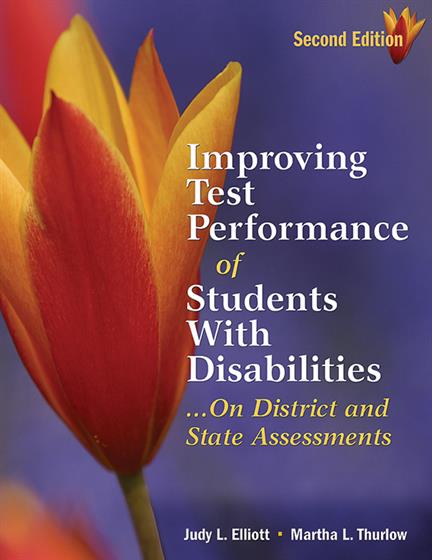Preface
Acknowledgments
About the Authors
1. Maximizing the Performance of Students With Disabilities
Incorporating Standards Into Assessment and Instruction
Using Data to Drive Assessment and Instruction
Making Good Decisions About Accommodations
Helping the Student Prepare for Testing
Addressing the Needs of IEP/ELLs
Improving Test Performance on the General Assessment Through Instruction
Improving Performance on the Alternate Assessment Through Instruction
Generating Parent Support – and the Support of Others, Too
Summary
Test Your Knowledge
Resources
Internet Resources
2. Standards-Based Assessment and Instruction
Changing the Tide
Where is Lake Wobegon, Anyway?
Trademarks of a Standards-Based Classroom
Aligning IEPs With Standards
Linking the IEP to Standards
Content Standard: Reading
Summary
Test Your Knowledge
Reflections on Change
Resources
Internet Resources
3. Using Data to Drive Instruction
Opportunities and Challenges
Basic Data to Know
Case Study Discussion
Questions You Should Be Asking, Answers You Should Know
Principals/District Site Administrators
Teachers
Parents
Board Members
Superintendents
Summary
Test Your Knowledge
Reflections on Change
Resources
Internet Resources
Chapters 1-3. Self Check: Where Do I Stand?
4. Making Sound Accommodations Decisions
Opinions Versus Research-Based Knowledge on Accommodations
Court Cases and Settlements
Considerations in Making Decisions About Accommodations
Considerations in Making Decisions About Accommodations
Steps to Take in Identifying Accommodations for Individual Students
Rolling Classroom Accommodations into District and State Assessments
A Word About Technology Accommodations
A Word About Technology Accommodations
A Word About Technology Accommodations
Non-Approved Accommodations
Alternative Route to Diploma or Promotion
Summary
Test Your Knowledge
Resources
Reflections on Change
Resources
Internet Resources
5. Preparing Students for Testing
Causes and Considerations
Assessment Literacy
Setting Goals, Targets, and Expectations
Preparing Daily for the Test
Helping Students Become Advocates for Their Own Testing Needs
Summary
Test Your Knowledge
Reflections on Change
Resources
Internet Resources
6. Addressing the Needs of IEP/ELLs
Who Are IEP/ELLs?
Participation of IEP/ELLS in District and State Assessments
Accommodations
Assessment Performance
Instruction for IEP/ELLS
Summary
Test Your Knowledge
Reflections on Change
Resources
Internet Resources
Chapters 4-6. Self-Check: Where Do I Stand?
7. Improving Performance on General Assessment Through Instruction
Where the Rubber Meets the Road
The Realities
The Million Dollar Question
Preparing for Instruction: The Planning Pyramid
What Do We Know About Effective Instruction?
Improving Student Performance: A Model of Effective Instruction
Planning Instruction
Managing Instruction
Delivering Instruction
Evaluating Instruction
Summary
Test Your Knowledge
Reflections on Change
Resources
Internet Resources
8. Improving Performance on Alternate Assessments Through Instruction
Federal Requirements That Guide Alternate Assessments
What We Knew Then
Where We Are Now
What Has Changed
High Standards for Learning for Alternate Assessment Students
The Impact of Alternate Assessment on Instruction
Summary
Test Your Knowledge
Reflections on Change
Resources
Internet Resources
9. Parent Support for Student Performance
Informing Parents About Tests
Equipping Parents to Make Good Participation and Accommodation Decisions
Helping Parents Understand Test Results
Understanding General Test Results
Understanding Their Child’s Test Results
Summary
Test Your Knowledge
Reflections on Change
Resources
Internet Resources
Chapters 7-9. Self Check: Where Do I Stand?
Appendix A: Reflection on Change
Appendix B: Technical Assistance and Dissemination Networks
Index
Figures and Reproducible Forms
Box 1.1: Key Elements of IDEA 97 and NCLB
Box 1.2: Assumptions About Including Students With Disabilities
Box 2.1: Examples of Content and Performance Standards
Box 2.2: IEP Format Linking District Standards and Student Annual Goals
Box 2.3: Steps for Unpacking Standards
Box 2.4: Bloom’s Taxonomy
Box 2.5: A Framework for Unpacking Standards
Box 2.6: Unpacking Standards: Supporting the Process
Box 3.1: Strategies for Success (SFS) Overview
Box 3.2: SFS Grade Results
Box 3.3: Reading Program Comparison
Box 3.4: A Case Study
Box 4.1: Examples of Six Types of Assessment Accommodations
Box 4.2: Kyle’s Access to the General Education Curriculum With and Without Accommodations
Box 4.3: Summary of Selected Research Syntheses on Accommodations
Box 4.4: Common Instructional Accommodations, A-Z
Form 4.1: Classroom Accommodations Worksheet
Box 4.6: Student Accommodations Questionnaire
Box 4.7: Tracking the Effects of Accommodations
Box 4.8: Case Study on Tracking the Effects of Accommodations
Form 4.2: Form to Determine Links Between Classroom Accommodations, Classroom Testing Accommodations, and State or District Testing Accommodations
Box 4.9: Case Study on Making Accommodations Decisions for Instruction and Testing
Box 4.10: Case Study on Planning Accommodations
Box 5.1: Self Regulation and Time Management
Box 5.2: Selected Assessment Terminology and Definitions
Box 5.3: Points to Make in discussing the Purpose of State and District Assessments
Box 5.4: Example of a Test Matrix for a “Typical” Standards-Based State Test
Box 5.5: Example of a Test Matrix for a “Typical” Norm-Referenced Test
Box 5.6: Partial Test Matrix Analysis
Box 5.7: Considering the Unique Needs of Students Who Are Blind or Visually Impaired
Box 5.8: Common Test Vocabulary Terms
Box 5.9: Suggestions for Answering Different Types of Questions
Box 5.10: Self-Regulation and Time Management
Box 6.1: Clarification of Terminology
Box 6.2: Percentages of All IEP Students and IEP/ELLs by Category
Box 6.3: Examples of Linguistic Accommodations
Box 6.4: Considerations for Assessing LEP Students
Box 6.5: Strategies Identified as Important for IEP/ELLs
Box 7.1: Instructional Planning Pyramid
Box 7.2: Guiding Questions for the Planning Pyramid
Box 7.3: Some Research-Based Findings on Characteristics of Effective Instruction
Box 7.4: Components of Effective Instruction
Box 7.5: Deciding What to Teach: Think About It
Box 7.6: How to Teach: Think About It
Box 7.7: Communicate Realistic Expectations: Think About It
Box 7.8: Prepare for Instruction: Think About It
Box 7.9: Use Time Productively: Think About It
Box 7.10: Establishing a Positive Classroom Environment: Think About It
Box 7.11: Presenting Information: Think About It
Box 7.12: Monitoring Presentations: Think About It
Box 7.13: Adjusting Presentations: Think About It
Box 7.14: Monitor Student Understanding: Think About It
Box 7.15: Monitoring Engaged Time: Think About It
Box 7.16: Keep Records of Student Progress: Think About It
Box 7.17: Use Data to Make Decisions: Think About It
Box 8.1: Federal Documents that Clarify Alternate Assessments Performance Benchmarks
Box 8.2: Definitions of Basic Terms Used in Relation to Alternate Assessment
Box 8.3: Examples of Standards of Learning for Alternate Assessments in Massachusetts
Box 8.4: Examples of Instructional Idea, Strategies, and Entry Points in Massachusetts
Box 8.5: Selections From High School Course Outline
Box 9.1: A Parent Version of a Test Matrix
Box 9.2: Excerpt from Federation of Families Report
Box 9.3: Parent Questions and Answers About State and District Assessments
Box 9.4: NRTs Versus CRTs and Standards-Based Assessments
Box 9.5: Resource Centers and Materials for Parents
Box 9.6: Guide for Translating Testing Terminology for Parents
Box 9.7: Example of Information Presented in State Report



